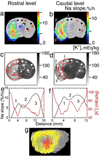Correlated sodium and potassium imbalances within the ischemic core in experimental stroke: a 23Na MRI and histochemical imaging study
- PMID: 23792152
- PMCID: PMC3885320
- DOI: 10.1016/j.brainres.2013.06.012
Correlated sodium and potassium imbalances within the ischemic core in experimental stroke: a 23Na MRI and histochemical imaging study
Abstract
This study addresses the spatial relation between local Na(+) and K(+) imbalances in the ischemic core in a rat model of focal ischemic stroke. Quantitative [Na(+)] and [K(+)] brain maps were obtained by (23)Na MRI and histochemical K(+) staining, respectively, and calibrated by emission flame photometry of the micropunch brain samples. Stroke location was verified by diffusion MRI, by changes in tissue surface reflectivity and by immunohistochemistry with microtubule-associated protein 2 antibody. Na(+) and K(+) distribution within the ischemic core was inhomogeneous, with the maximum [Na(+)] increase and [K(+)] decrease typically observed in peripheral regions of the ischemic core. The pattern of the [K(+)] decrease matched the maximum rate of [Na(+)] increase ('slope'). Some residual mismatch between the sites of maximum Na(+) and K(+) imbalances was attributed to the different channels and pathways involved in transport of the two ions. A linear regression of the [Na(+)]br vs. [K(+)]br in the samples of ischemic brain indicates that for each K(+) equivalent leaving ischemic tissue, 0.8±0.1 Eq, on average, of Na(+) enter the tissue. Better understanding of the mechanistic link between the Na(+) influx and K(+) egress would validate the (23)Na MRI slope as a candidate biomarker and a complementary tool for assessing ischemic damage and treatment planning.
Keywords: (23)Na MRI; 3D; ADC; BBB; Focal ischemia; MAP2; MCA, MCAO, MCAT; Permanent MCAO; RF; ROI; Rat brain; Tissue potassium; Tissue sodium; [Na(+)](br) and [K(+)](br); apparent diffusion coefficient; blood–brain barrier; brain tissue sodium and potassium concentration, respectively; microtubule-associated protein 2; middle cerebral artery, MCA occlusion, and MCA transection with bilateral common carotid artery occlusion, respectively; radiofrequency; region of interest; three-dimensional.
Copyright © 2013. Published by Elsevier B.V.
Figures





Similar articles
-
Inhomogeneous sodium accumulation in the ischemic core in rat focal cerebral ischemia by 23Na MRI.J Magn Reson Imaging. 2009 Jul;30(1):18-24. doi: 10.1002/jmri.21816. J Magn Reson Imaging. 2009. PMID: 19557842 Free PMC article.
-
Brain tissue sodium is a ticking clock telling time after arterial occlusion in rat focal cerebral ischemia.Stroke. 2000 Jun;31(6):1386-91; discussion 1392. doi: 10.1161/01.str.31.6.1386. Stroke. 2000. PMID: 10835461
-
K⁺ dynamics in ischemic rat brain in vivo by ⁸⁷Rb MRI at 7 T.NMR Biomed. 2011 Aug;24(7):778-83. doi: 10.1002/nbm.1652. Epub 2011 Jan 25. NMR Biomed. 2011. PMID: 21834001 Free PMC article.
-
Blood-brain barrier Na transporters in ischemic stroke.Adv Pharmacol. 2014;71:113-46. doi: 10.1016/bs.apha.2014.06.011. Epub 2014 Aug 23. Adv Pharmacol. 2014. PMID: 25307215 Review.
-
Potassium homeostasis in the ischemic brain.Glia. 2005 Jun;50(4):407-416. doi: 10.1002/glia.20145. Glia. 2005. PMID: 15846795 Review.
Cited by
-
Voltage-gated potassium channels at the crossroads of neuronal function, ischemic tolerance, and neurodegeneration.Transl Stroke Res. 2014 Feb;5(1):38-58. doi: 10.1007/s12975-013-0297-7. Epub 2013 Nov 19. Transl Stroke Res. 2014. PMID: 24323720 Free PMC article. Review.
-
Postischemic Inflammation in Acute Stroke.J Clin Neurol. 2017 Jan;13(1):1-9. doi: 10.3988/jcn.2017.13.1.1. J Clin Neurol. 2017. PMID: 28079313 Free PMC article. Review.
-
Exposure to 16 h of normobaric hypoxia induces ionic edema in the healthy brain.Nat Commun. 2021 Oct 13;12(1):5987. doi: 10.1038/s41467-021-26116-y. Nat Commun. 2021. PMID: 34645793 Free PMC article.
-
Understanding the Connection Between Common Stroke Comorbidities, Their Associated Inflammation, and the Course of the Cerebral Ischemia/Reperfusion Cascade.Front Immunol. 2021 Nov 15;12:782569. doi: 10.3389/fimmu.2021.782569. eCollection 2021. Front Immunol. 2021. PMID: 34868060 Free PMC article. Review.
-
Alterations of Iron Level in the Bilateral Basal Ganglia Region in Patients With Middle Cerebral Artery Occlusion.Front Neurosci. 2021 Jan 21;14:608058. doi: 10.3389/fnins.2020.608058. eCollection 2020. Front Neurosci. 2021. PMID: 33551726 Free PMC article.
References
-
- Belayev L, Alonso OF, Busto R, Zhao W, Ginsberg MD. Middle cerebral artery occlusion in the rat by intraluminal suture. Neurological and pathological evaluation of an improved model. Stroke. 1996;27:1616–1622. - PubMed
-
- Betz AL, Keep RF, Beer ME, Ren X. Blood-brain barrier permeability and brain concentration of sodium, potassium, and chloride during focal ischemia. J. Cereb. Blood Flow Metab. 1994;14:29–37. - PubMed
-
- Boada FE, Gillen JS, Noll DC, Shen GX, Chang SY, Thulborn KR. Data acquisition and postprocessing strategies for fast quantitative sodium imaging. Int. J. Imaging Syst. Technol. 1997a;8:544–550.
-
- Boada FE, Gillen JS, Shen GX, Chang SY, Thulborn KR. Fast three dimensional sodium imaging. Magn. Reson. Med. 1997b;37:706–715. - PubMed
Publication types
MeSH terms
Substances
Grants and funding
LinkOut - more resources
Full Text Sources
Other Literature Sources
Medical

